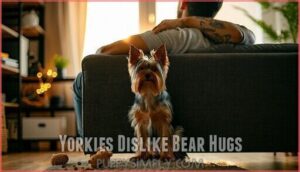This site is supported by our readers. We may earn a commission, at no cost to you, if you purchase through links.

That history created dogs who don’t just tolerate physical closeness—they crave it. Most Yorkies are natural cuddlers who seek out warmth and contact with their favorite people. But there’s a catch: they have strong preferences about how they receive affection, and getting it wrong can make your pup uncomfortable or anxious.
Table Of Contents
- Key Takeaways
- Yorkies Adore Physical Affection
- Cuddling Benefits Dogs and Owners
- Dealing With Separation Anxiety
- Understanding a Yorkie’s Pedigree
- Yorkshire Terrier Temperament
- Yorkies Dislike Bear Hugs
- Alternatives to Hugging Yorkies
- Frequently Asked Questions (FAQs)
- Do Yorkies love to be held and cuddled?
- Do dogs enjoy cuddling?
- Are Yorkshire Terriers good cuddlers?
- Why do Yorkies Stare a lot?
- How much exercise does a Yorkshire Terrier need daily?
- What are some common health issues seen in Yorkshire Terriers?
- What type of food should Yorkshire Terriers eat?
- How often should I brush my Yorkshire Terrier’s hair?
- What kind of toys do Yorkshire Terriers enjoy playing with?
- How often should I cuddle my Yorkie daily?
- Conclusion
Key Takeaways
- Yorkies are hardwired to crave physical closeness because they were bred to work alongside humans in tight quarters, making about 81% of them natural cuddlers who actively seek warmth and contact with their owners.
- Cuddling triggers measurable physiological benefits for both dogs and humans, including oxytocin spikes that strengthen bonds, cortisol drops that reduce stress by up to 33.5%, and lower blood pressure in both species.
- While Yorkies love affection, they strongly dislike tight bear hugs that make them feel trapped—instead, they prefer gentle alternatives like belly rubs, grooming sessions, or simply leaning against you on their own terms.
- Excessive cuddling without teaching independence can backfire into separation anxiety, so balance physical affection with solo play and consistent routines to prevent your Yorkie from becoming overly dependent.
Yorkies Adore Physical Affection
If you’ve ever owned a Yorkie, you know they’re not shy about showing love. These little dogs have their own unique ways of telling you they’re completely devoted to you.
Let’s look at two telltale signs your Yorkie is head over heels for physical affection.
Staring at Owners
If you’ve ever caught your Yorkie locked in an unblinking gaze—eyes fixed on you like you’re the most fascinating thing in the room—you’re witnessing one of the breed’s most endearing quirks. This staring behavior isn’t random. It’s their way of staying connected and reading your facial expressions for cues about what happens next. That intense canine gaze reveals:
- Deep emotional attachment to their favorite person
- Sharp intelligence trying to decode your next move
- Natural curiosity about everything you do
- A strong desire for owner affection and physical closeness
This constant eye contact strengthens your bond and sets the stage for all those cuddle sessions Yorkies crave.
Needing Constant Attention
Beyond that steady gaze, your Yorkie craves something even more demanding—your full attention, pretty much all the time. This constant companionship need isn’t just about loyalty—it’s attention-seeking rooted in their breeding as lap dogs.
Without regular interaction, clingy behavior can spiral into dependency issues and separation anxiety. Balance cuddle time with solo play using interactive toys to prevent emotional support from becoming unhealthy attachment while keeping that affection strong.
Cuddling Benefits Dogs and Owners
When you snuggle up with your Yorkie, you’re both getting more than just a cozy moment. Cuddling creates real physical and emotional benefits that strengthen your bond and boost well-being for both of you.
Here’s what actually happens during those sweet cuddle sessions.
Dogs Enjoy Physical Touch
Your Yorkie isn’t just tolerating those gentle pets and scratches—they’re hardwired to crave them. Physical touch triggers a cascade of feel-good responses in your dog’s brain, making every stroke and snuggle deeply rewarding. Through touch therapy and simple petting techniques, you’re delivering sensory stimulation that provides genuine physical comfort.
When you cuddle your Yorkie, you’re communicating in a language they instinctively understand:
- Trust – Your Yorkie feels safe enough to be vulnerable in your arms
- Connection – Dog cuddling creates canine affection that deepens your relationship
- Joy – These moments of Yorkie affection and trust genuinely make them happy
Even basic canine massage techniques reduce anxiety while strengthening your bond through affection.
Oxytocin Strengthens Bonds
That feel-good warmth you both experience during cuddle sessions? It’s oxytocin at work. When you pet, hold, or even lock eyes with your Yorkie, oxytocin floods both your systems—sometimes spiking by hundreds of percentage points.
This hormone creates a positive feedback loop: your affection triggers oxytocin release in your dog, which prompts them to seek more contact, which then boosts your own oxytocin levels. Studies show this hormonal balance strengthens social attachment remarkably—owners with higher oxytocin engage more calmly with their Yorkies, while their dogs display fewer anxious behaviors.
Cuddling your Yorkie triggers a mutual oxytocin surge that creates a self-reinforcing cycle of affection and calm between both of you
It’s the same biological mechanism that bonds mothers to infants, now connecting you to your canine companion. The oxytocin release is also influenced by social bonding mechanisms that occur during interactions between humans and dogs.
Reduces Stress and Anxiety
Emotional relief isn’t just a nice feeling—it’s measurable physiology. When you cuddle your Yorkie, both of you experience drops in cortisol (your stress hormone) and increases in calming serotonin. College students petting therapy dogs showed 33.5% reductions in self-reported stress after just fifteen minutes.
That physical affection translates to lower blood pressure and steadier heart rates in both species. Your Yorkie becomes a living stress-reduction tool, offering anxiety alleviation through the simplest calming technique: closeness.
These comfort dogs provide genuine emotional support backed by hard science. Interacting with dogs can have a positive impact on our mental health benefits.
Dealing With Separation Anxiety
When you cuddle your Yorkie too much, you might accidentally create a problem that’s tough to undo. Separation anxiety can turn your confident little companion into a nervous wreck when you’re not around.
Let’s look at how to spot the warning signs and what you can do to help your Yorkie feel more secure.
Recognizing The Signs
Watch closely—separation anxiety doesn’t shout, it whispers through subtle canine communication. When Yorkies like to cuddle excessively or panic when you leave, they’re sending clear emotional cues. Understanding Yorkie behavior means spotting these affection signs:
- Frantic pacing or destructive behavior when you grab your keys
- Excessive whining or barking the moment you step toward the door
- Following you everywhere, refusing to settle even briefly alone
These body language signals and cuddle habits reveal anxiety, not just attachment.
Soothe The Yorkie
Patience becomes your most powerful tool when anxiety takes hold of your tiny companion. Understanding Yorkie behavior and temperament means recognizing that affection heals anxiety better than any quick fix. Try these calming techniques: gentle petting along their back, soft reassuring words, and creating a cozy space where Yorkies feel secure. Your emotional support through consistent relaxation methods helps ease their worry.
| Calming Technique | How It Soothes Your Yorkie |
|---|---|
| Gentle stroking | Releases oxytocin, deepening your bond and reducing stress |
| Quiet cuddle time | Provides Yorkie comfort through physical closeness and warmth |
| Consistent routine | Builds trust and predictability, easing separation anxiety |
Understanding a Yorkie’s Pedigree
Your Yorkie’s bloodline tells a story that explains why your little lapdog acts more like a fearless hunter than a dainty companion. Back in 1800s Yorkshire, England, these tiny terriers weren’t bred for luxury—they worked hard in mines and textile mills, hunting rats in tight spaces where bigger dogs couldn’t fit.
This breeding history shaped three key genetic traits you’ll see in your Yorkie today:
- Bold, confident personality that doesn’t match their 4-7 pound frame
- High energy levels and quick reflexes from their working terrier ancestral roots
- Strong attachment to owners developed through close quarters work alongside humans
Understanding your Yorkshire Terrier’s pedigree analysis reveals why breed characteristics include that signature mix of fearlessness and affection.
Your Yorkie’s family lineage explains their need for both adventure and cuddles—they’re hardwired to work closely with you while maintaining their scrappy independence. That’s not contradictory behavior; it’s generations of Yorkshire terrier breeding creating the perfect companion dog.
Yorkshire Terrier Temperament
Think of a Yorkshire terrier as a lion trapped in a toy dog’s body—that’s the essence of breed characteristics you’ll encounter. These pint-sized terriers rank in the top 30 for canine intelligence, learning new commands in just 15 to 25 repetitions.
You’ll notice 85% show daily bursts of energetic play, chasing toys and zooming around despite their delicate frames. But here’s the catch: 53% display stubbornness during training without high-value treats as motivation. Effective training methods rely on positive reinforcement and consistency—skip those, and your Yorkie will test every boundary.
Early Yorkie socialization between three and twelve weeks dramatically reduces anxious behaviors, making cuddle time more enjoyable for both of you. Their confident, sometimes sassy personalities mean they’ll shower you with affection on their terms, following you room to room while occasionally choosing solo nap spots. Understanding these dog personality traits and canine emotions helps you nurture the perfect balance of independence and devotion.
Yorkies Dislike Bear Hugs
Your Yorkie might love snuggling beside you, but tight bear hugs are a different story. Dogs generally feel trapped when arms wrap fully around them, which can trigger stress rather than comfort.
Let’s look at how to keep affection safe and enjoyable for your little companion.
Children Must Be Gentle
Kids have a knack for squeezing things they love—stuffed animals, pets, and yes, even tiny Yorkies—but these little dogs need a softer touch. Teach your children that gentle interaction means petting, not hugging.
Always supervise playtime so you can guide those enthusiastic little hands toward soft management that respects Yorkie boundaries. When your kids show affection the right way, praise them—it builds kid safety habits and helps your Yorkie feel secure. This kind of child education creates a bond built on trust, not stress.
Respect Signals of Discomfort
When your Yorkie freezes, licks her lips, or turns away during cuddle time, she’s speaking a language that’s easy to miss if you don’t know what to look for. Learning dog body language helps you respect personal space and avoid pushing boundaries.
Watch for these discomfort signs:
- Yawning when not tired
- Nose licking or lip smacking
- Turning her head away
- Backing up or leaving
A gentle approach and calming techniques let your Yorkie set the pace for affection.
Alternatives to Hugging Yorkies
If bear hugs make your Yorkie uncomfortable, you’ve got plenty of other ways to show affection that they’ll actually enjoy.
These gentler approaches respect their boundaries while still strengthening your bond. Let’s look at two tried-and-true options that most Yorkies love.
Grooming
A soft-bristled brush gliding through that glossy coat isn’t just grooming—it’s a tender conversation your Yorkie understands without words. Daily brushing techniques prevent tangles while building trust through gentle touch.
Nail trimming and coat maintenance become bonding rituals that keep your Yorkie healthy without overwhelming them. This fur care routine offers shedding control and shows affection your dog actually craves—no bear hugs required.
Belly Rubs
If grooming’s the warm-up, belly rubs are your Yorkie’s favorite main event—and they’ll happily roll over to prove it. Gentle touch and soft petting release oxytocin, strengthening your bond without overwhelming your affectionate Yorkie.
Use slow tummy strokes—long, smooth rub techniques that show you understand dog cuddling and affection. Watch for Yorkie cuddle behavior like exposed bellies and relaxed ears. This belly massage respects their boundaries while satisfying their need to cuddle naturally.
Frequently Asked Questions (FAQs)
Do Yorkies love to be held and cuddled?
Most Yorkshire terriers thrive on close contact with their owners. They’re bred as companion dogs, so cuddling feels natural to them.
In fact, surveys show about 81% of Yorkies love to cuddle, making them one of the most affectionate breeds around.
Do dogs enjoy cuddling?
Most dogs thrive on physical touch and cuddling. Canine cuddle needs vary by breed, but affectionate breeds like Yorkies especially enjoy cuddling because it releases oxytocin, strengthening bonds and providing emotional support through animal bonding methods that offer real cuddle therapy benefits.
Are Yorkshire Terriers good cuddlers?
Yorkshire terriers rank among the most affectionate breeds despite their small size—a delightful contradiction. With breed characteristics favoring canine attachment, 81% of Yorkies love cuddling.
Their affection levels run high, making them excellent cuddlers who thrive on physical closeness.
Why do Yorkies Stare a lot?
Yorkies stare because it’s their way of bonding with you. Eye contact releases oxytocin in both of you, strengthening your connection. They’re reading your emotions and showing affection through their gaze.
How much exercise does a Yorkshire Terrier need daily?
Your Yorkie needs 30 to 40 minutes of daily exercise to stay physically fit and mentally sharp. Two short walks or playtime activities work well for these small breed dogs.
Indoor games tap into their natural curiosity while preventing boredom-related mischief.
What are some common health issues seen in Yorkshire Terriers?
Despite their hardy spirit, Yorkshire terriers face canine health and wellness challenges. Hypoglycemia Risks affect toy breeds, while Dental Issues, Luxating Patellas, collapsed tracheas, Legg Calve Perthes disease, and Portosystemic Shunt require monitoring.
Regular vet visits help catch Yorkies and Health Issues early, supporting your Yorkie Health and Comfort through preventive dog health care.
What type of food should Yorkshire Terriers eat?
Your Yorkie thrives on high-quality kibble designed for small breeds—look for real meat as the first ingredient. Feed twice daily in measured portions, skip grain-heavy options, and keep treats minimal.
When nutrition plans or feeding schedules feel confusing, your vet can tailor meal prep to support peak canine health.
How often should I brush my Yorkshire Terrier’s hair?
Daily brushing keeps your Yorkshire terrier’s long hair tangle-free and beautiful.
Use a pin brush and metal comb to work through the coat gently, preventing mats that can pull at the skin and cause discomfort.
What kind of toys do Yorkshire Terriers enjoy playing with?
Small, interactive toys keep your Yorkie mentally sharp and physically active. Plush toys, squeaky balls, and tug toys satisfy their natural hunting instincts. Rotate options regularly to prevent boredom during playtime.
How often should I cuddle my Yorkie daily?
You might think cuddle frequency needs a strict schedule, but Yorkies thrive on flexible daily affection.
Several gentle petting sessions throughout the day strengthen your emotional connection and satisfy their bonding needs without overwhelming them.
Conclusion
Think of your Yorkie as a Victorian mill worker who learned that staying close to their human partner wasn’t just preference—it was survival. That instinct hasn’t faded.
Most Yorkies do like to cuddle, but they need you to respect their terms. Skip the tight hugs that trigger their flight response. Instead, let them burrow into your lap, lean against your side, or settle near your feet.
When you honor their boundaries while meeting their need for closeness, you’re not just cuddling—you’re speaking their ancestral language of trust.
- https://pawsandlearn.com/do-yorkies-like-to-cuddle-and-be-held-what-owners-say/
- https://www.petmd.com/dog/breeds/yorkshire-terrier
- https://dogtrainersboston.com/the-feisty-charm-understanding-the-personality-traits-and-temperament-of-yorkshire-terriers/
- https://fortmyersvet.com/spotlight-on-the-yorkie/
- https://www.douglashallkennels.co.uk/yorkshire-terrier/why-yorkshire-terriers-love-to-snuggle-the-science-behind-it/














